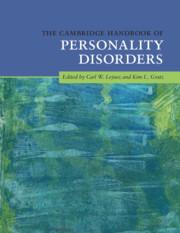Book contents
- The Cambridge Handbook of Personality Disorders
- The Cambridge Handbook of Personality Disorders
- Copyright page
- Contents
- Figures
- Tables
- Contributors
- Preface
- Part I Etiology
- Part II Models
- Part III Individual Disorders and Clusters
- Part IV Assessment
- Part V Treatment
- 17 Cognitive Behavioral Approaches
- 17a Applying a Cognitive-Behavioral, Principle-Based Approach to the Treatment of Personality Disorders: Commentary on Cognitive Behavioral Approaches
- 17b Implementation Challenges in Real World Settings: Commentary on Cognitive Behavioral Approaches
- 17c Further Considerations about Cognitive Behavioral Therapies and Personality Disorders: Author Rejoinder to Commentaries on Cognitive Behavioral Approaches
- 18 Psychoanalytic/Psychodynamic Approaches to Personality Disorders
- 18a Contemporary Psychodynamic Treatments: Commentary on Psychoanalytic/Psychodynamic Approaches to Personality Disorders
- 18b Consideration of Commonalities in Distinct Models of Treatment for Individuals with Borderline Personality Disorder: Commentary on Psychoanalytic/Psychodynamic Approaches to Personality Disorders
- 18c Further Development of Three Key Issues: Author Rejoinder to Commentaries on Psychoanalytic/Psychodynamic Approaches to Personality Disorders
- 19 Using DSM-5 and ICD-11 Personality Traits in Clinical Treatment
- 19a A Functional Understanding of the Relationship between Personality and Clinical Diagnoses and Implications for Treatment Planning: Commentary on Using DSM-5 and ICD-11 Personality Traits in Clinical Treatment
- 19b The Need for Mechanistic Models to Translate Traits from Bench to Bedside: Commentary on Using DSM-5 and ICD-11 Personality Traits in Clinical Treatment
- 19c Simplicity and Dynamics of the ICD-11 Trait Qualifiers in Relation to Treatment: Author Rejoinder to Commentaries on Using DSM-5 and ICD-11 Personality Traits in Clinical Treatment
- 20 Brief Therapeutic Approaches for Personality Disorders
- 20a What Knowledge Is Lacking on Brief Interventions for Personality Disorders and Why: Commentary on Brief Therapeutic Approaches for Personality Disorders
- 20b Short- and Long-Term Personality Disorder Treatment Studies Should Inform One Another: Commentary on Brief Therapeutic Approaches for Personality Disorders
- 20c Next Steps: Author Rejoinder to Commentaries on Brief Therapeutic Approaches for Personality Disorders
- 21 Recent Developments in the Pharmacologic Management of Personality Disorders
- 21a New Efforts towards Evidence-Informed Practice and Practice-Informed Research: Commentary on Recent Developments in the Pharmacologic Management of Personality Disorders
- 21b Considerations Regarding the Pharmacological Management of Personality Disorders: Commentary on Recent Developments in the Pharmacologic Management of Personality Disorders
- 21c Directions for Future Drug Trial Research: Author Rejoinder to Commentaries on Recent Developments in the Pharmacologic Management of Personality Disorders
- Index
- References
19 - Using DSM-5 and ICD-11 Personality Traits in Clinical Treatment
from Part V - Treatment
Published online by Cambridge University Press: 24 February 2020
- The Cambridge Handbook of Personality Disorders
- The Cambridge Handbook of Personality Disorders
- Copyright page
- Contents
- Figures
- Tables
- Contributors
- Preface
- Part I Etiology
- Part II Models
- Part III Individual Disorders and Clusters
- Part IV Assessment
- Part V Treatment
- 17 Cognitive Behavioral Approaches
- 17a Applying a Cognitive-Behavioral, Principle-Based Approach to the Treatment of Personality Disorders: Commentary on Cognitive Behavioral Approaches
- 17b Implementation Challenges in Real World Settings: Commentary on Cognitive Behavioral Approaches
- 17c Further Considerations about Cognitive Behavioral Therapies and Personality Disorders: Author Rejoinder to Commentaries on Cognitive Behavioral Approaches
- 18 Psychoanalytic/Psychodynamic Approaches to Personality Disorders
- 18a Contemporary Psychodynamic Treatments: Commentary on Psychoanalytic/Psychodynamic Approaches to Personality Disorders
- 18b Consideration of Commonalities in Distinct Models of Treatment for Individuals with Borderline Personality Disorder: Commentary on Psychoanalytic/Psychodynamic Approaches to Personality Disorders
- 18c Further Development of Three Key Issues: Author Rejoinder to Commentaries on Psychoanalytic/Psychodynamic Approaches to Personality Disorders
- 19 Using DSM-5 and ICD-11 Personality Traits in Clinical Treatment
- 19a A Functional Understanding of the Relationship between Personality and Clinical Diagnoses and Implications for Treatment Planning: Commentary on Using DSM-5 and ICD-11 Personality Traits in Clinical Treatment
- 19b The Need for Mechanistic Models to Translate Traits from Bench to Bedside: Commentary on Using DSM-5 and ICD-11 Personality Traits in Clinical Treatment
- 19c Simplicity and Dynamics of the ICD-11 Trait Qualifiers in Relation to Treatment: Author Rejoinder to Commentaries on Using DSM-5 and ICD-11 Personality Traits in Clinical Treatment
- 20 Brief Therapeutic Approaches for Personality Disorders
- 20a What Knowledge Is Lacking on Brief Interventions for Personality Disorders and Why: Commentary on Brief Therapeutic Approaches for Personality Disorders
- 20b Short- and Long-Term Personality Disorder Treatment Studies Should Inform One Another: Commentary on Brief Therapeutic Approaches for Personality Disorders
- 20c Next Steps: Author Rejoinder to Commentaries on Brief Therapeutic Approaches for Personality Disorders
- 21 Recent Developments in the Pharmacologic Management of Personality Disorders
- 21a New Efforts towards Evidence-Informed Practice and Practice-Informed Research: Commentary on Recent Developments in the Pharmacologic Management of Personality Disorders
- 21b Considerations Regarding the Pharmacological Management of Personality Disorders: Commentary on Recent Developments in the Pharmacologic Management of Personality Disorders
- 21c Directions for Future Drug Trial Research: Author Rejoinder to Commentaries on Recent Developments in the Pharmacologic Management of Personality Disorders
- Index
- References
Summary
The DSM-5 Alternative Model of Personality Disorders (AMPD) and the ICD-11 Classification of Personality Disorders allow clinicians to describe trait domains that contribute to the unique expression of personality dysfunction. Both diagnostic systems deliniate trait domain features of negative affectivity, detachment, antagonism/dissociality, disinhibition, and anankastia/compulsivity, which may inform clinicians about how to manage treatment. This chapter specifically describes how the DSM-5 and ICD-11 trait domains may be useful for establishing a favorable treatment alliance, doing therapeutic assessment, increasing the patient’s self-knowledge, providing psychoeducation, planning realistic treatment goals, and matching therapy to the patient’s personality. A key message of this chapter is that practitioners should not treat traits per se but the maladaptive expressions of traits.
Keywords
- Type
- Chapter
- Information
- The Cambridge Handbook of Personality Disorders , pp. 450 - 467Publisher: Cambridge University PressPrint publication year: 2020
References
- 18
- Cited by

